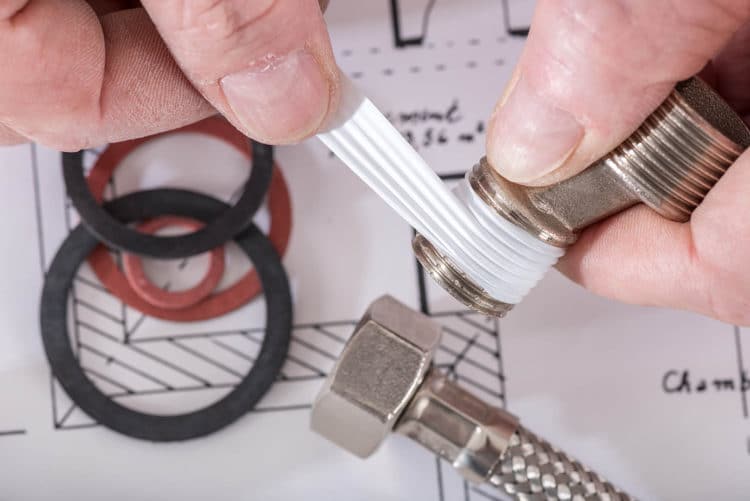Teflon tape is a type of thread seal tape made from polytetrafluoroethylene (PTFE). This product comes cut to specific widths and wound on spools to make it easy to install on pipe threads.
The product design uses lubrication to provide a deeper seating of the threads, preventing the connection from seizing when unscrewed. It also works as a flexible filler to seal joints without using a hardening compound.
That makes a connection fitted with Teflon tape easier to tighten. The threads avoid direct contact to prolong wear while preventing leaks.
Can You Use Teflon Tape on Gas Pipe Fittings?
Yellow Teflon tape is suitable for gas pipe fittings. It is often used for connecting grills, stoves, and other appliances to existing utility lines. This product seals the threads at the connection to ensure leaks cannot develop. Different PTFE tape colors are not rated to provide this outcome.
Bill Bently is responsible for developing the color-coding system for thread sealing tap products. He worked at Unasco Pty Ltd in the 1970s, and the standards still apply today.
When you want to connect gas pipelines and fittings to an appliance, grill, or stove, it’s essential to use yellow Teflon tape. It’s the only product meant for stopping leaks in this situation.
Although other tape colors are available, they’re meant to prevent water or oxygen leaks. Gray PTFE tape is intended for stainless steel fittings.
If you need to form a connection bond to a gas line, it’s important to use a product rated as a pro-grade item.
That’s what you’ll receive with the EZ-FLO Yellow Teflon Pipe Thread Tape. This 4-mil tape density delivers the highest grade sealant available with universal gas line application.
It secures connections on copper, brass, iron, steel, aluminum, and stainless steel lines. With the extra thickness, you can accomplish more with fewer wraps.
How to Install Teflon Tape on a Gas Pipe
Before working on any gas lines, please remember to turn off all connections to where you’re working. You don’t want to work on lines with any gas flowing through them.
You might need to turn the gas off at the meter. If that’s the case, you’ll need to remember to start your pilot lights again.
That includes your water heater, furnace, oven, fireplace, and even some air conditioners.
The only option to use on gas pipe connections is yellow Teflon tape. It cannot be used for water-based applications, and you cannot use other colors of PTFE tape for this fitting.
Yellow Teflon tape is designed to work on all gas line options. That includes natural gas, propane, and butane.
It provides a leak-proof option because of its double-density thickness, ensuring that it can handle the pressure delivered through the line.
The tape goes on the threads only, which is why it is sometimes called “thread tape.” You don’t want to use it on any compression connections or to try sealing a burst pipe or line.
You’ll wrap the tape between two to four times on the male end of the connection. That’s the one that has the threads exposed. Once it’s on securely, you can screw it into its installation location to have a secure seal.
The tape wraps tightly around the threads with its included lubrication, sealing the connection as it tightens.
After finishing the connection, you’ll want to test the line for leaks. After turning the gas on, mix some dish soap with water in a spray bottle. Shake it a little before spraying the mixture directly on the joint.
If you see bubbles forming, you have a gas leak to correct. Turn off the gas, tighten the fittings, and retry. Keep repeating until the solution no longer bubbles.
When a leak doesn’t stop, it often means you have dirt on the tape or it has been damaged. If you only wrapped the threads twice, try adding one more to see if that gives you a more secure fitting.
Will Teflon Tape Stop an Existing Gas Leak?
If you smell rotten eggs at home, call your gas company and 911 immediately after leaving your property. The fire department and the utility can inspect your lines and turn off the gas to ensure you are safe.
Calling in a house with a gas leak could ignite the escaping fuel. Only call once you’re safely away.
In this circumstance, do not attempt to fix any joints or potential leaks with Teflon tape. The only time to use this product is when you are connecting a new joint or replacing a degraded PTFE coating.
You might hear or see other signs and symptoms of a gas leak without smelling sulfur. Here are the symptoms to watch for if this repair becomes necessary.
- You hear a whistling or a hissing sound whenever you’re near the gas line.
- There is a visible dust cloud or a white color that hovers over the gas line.
- You can see bubbles in water or visible damage.
- The houseplants you’ve cared for are suddenly dead.
Some gas leaks are difficult to detect because the fuel filters to the outside before reaching any main rooms. You might have a higher bill than usual.
Gas leaks can cause carbon monoxide poisoning. Exposure is dangerous and requires medical treatment.
You might experience abdominal pain, dizziness, fatigue, headaches, and loss of muscle control. Some people develop bright red lips and pink skin.
Battery-operated carbon monoxide detectors are often mandatory in today’s building codes.
If you live in an older property, you might not have one. An easy way to complete this upgrade is to use a combination smoke and carbon monoxide detector.
Where to Install a Carbon Monoxide Detector
Carbon monoxide is slightly lighter than air. Since it is often found in rising warm air, the best place for a sensor is about five feet above the floor.
You can place a carbon monoxide detector or a combination unit with smoke sensing technology on the ceiling.
Some people like to place them next to gas appliances or fireplaces, but they shouldn’t be right over anything that produces a flame.
Each floor requires a separate detector to ensure you are safe. If you only purchase one, make sure it’s installed next to where you sleep and has an alarm that wakes you.
You’ll need to follow the manufacturer’s instructions to install the detector correctly. The product should come with a use and care booklet to offer appropriate guidelines to follow.
Teflon Tape Standards to Consider for Gas Applications
The United States uses two standards for determining the quality of Teflon tape today.
First, there is standard MIL-T-27730A. Although this option is considered an obsolete military specification, it’s still used quite often in the Teflon tape industry.
It requires a minimum thickness of 3.5-mil while maintaining PTFE purity levels of 99%.
The second is A-A-58092. This option is for commercial-grade products that maintain the thickness requirements of the previous military standard. It adds a minimum density of 1.2 grams per cubic centimeter.
Each industry can set various standards above those minimums. The PTFE tape for gas fittings, for example, is often required to be thicker than the products used for water-based applications.
Green Teflon tape is different from yellow and other colors because it is meant for oxygen applications.
Although it is technically a gas, it isn’t used for everyday fuel needs. This product must be grease-free to limit flammability risks because it operates in high-pressure environments.
Yellow Teflon tape is suitable for use on threads for gas lines from a half-inch to two inches. Many products are labeled as “gas tape” to ensure there is no confusion about its use.
Can I Overuse Yellow Teflon Tape?
If you place too much Teflon tape on threads, it can become a hazard. The added thickness can prevent the male and female connectors from fully engaging with each other. That outcome reduces the shear point of the application.
You can create a similar issue by combining Teflon tape with pipe dope.
Some gas lines can have their valve seat jammed when using this product. Internal overhangs can constrict the joint or cause the tape to slough away.
Can I Install Yellow Teflon Tape Myself?
Since yellow Teflon tape applies to gas connections, some utilities might not allow homeowners to complete this job. Local regulations often require grills, ovens, and other items to be installed by a tech to ensure their quality. Insurance policies can also stipulate this work be done by professionals.
If you’re unsure about your DIY skills, call for professional assistance. Although installing yellow Teflon tape is similar to the steps you’d follow for plumbing, it’s more dangerous to deal with gas than water.
The cost of hiring the local utility to complete this work is minimal to the potential costs you’d pay with an inappropriate joint that causes a gas leak.
When you have the skills to manage your gas lines, remember to use yellow Teflon tape only. That’ll give you the results you want!

